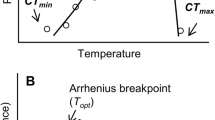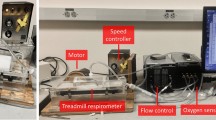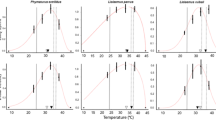Abstract
It is well established that the metabolic cost of horizontal locomotion decreases as a regular function of animal body mass, regardless of body form and phylogeny. How body size affects the cost of incline exercise remains much less clear. Studies on vertebrates have led to the hypotheses that the cost of vertical work is independent of body mass and that the added cost of locomoting on inclines is lower for small animals. Studies on vertebrates and a few invertebrates provide evidence both for and against these hypotheses. To gain further insight into the cost of incline exercise, we measured oxygen consumption of small (2.33 ± 0.07 g) and large (46.66 ± 5.33 g) ghost crabs (Ocypode quadrata) locomoting horizontally and up a 20° incline. The slope of the oxygen consumption versus speed relationship (= minimum cost of transport) was not significantly different for small crabs exercising horizontally and on an incline. However, the intercept for incline exercise was significantly higher, indicating that small crabs used more energy during incline exercise than during horizontal exercise. Incline had no effect on the slope or intercept of the oxygen consumption versus speed relationship for large crabs. Our results suggest that the cost of incline locomotion may be large for small animals and that the cost is not independent of body size. Our results add to the growing body of research indicating that body mass is but one factor that determines the cost of incline locomotion and efficiency of vertical work.



Similar content being viewed by others
References
Alexander RM (2005) Models and the scaling of energy costs for locomotion. J Exp Biol 208:1645–1652
Bamford OS, Maloiy MO (1980) Energy metabolism and heart rate during treadmill exercise in the marabou stork. J Appl Physiol 49:491–496
Blickhan R, Full RJ (1987) Locomotion energetics of the ghost crab II. Mechanics of the centre of mass during walking and running. J Exp Biol 130:155–174
Buck CL, Barnes MW (2000) Effects of ambient temperature on metabolic rate, respiratory quotient, and torpor in an arctic hibernator. Am J Physiol 279:R255–R262
Clapperton JL (1964) The energy metabolism of sheep walking on the level and on gradients. Br J Nutr 18:47–54
Cohen Y, Robbins CT, Davitt BB (1978) Oxygen utilization by elk calves during horizontal and vertical locomotion compared to other species. Comp Biochem Physiol 61A:43–48
Duch C, Pflüger HJ (1995) Motor patterns for horizontal and upside-down walking and vertical climbing in the locust. J Exp Biol 198:1963–1976
Eaton MD, Evans DL, Hodgson DR, Rose RJ (1995) Effect of treadmill incline and speed on metabolic rate during exercise in thoroughbred horses. J Appl Physiol 79(3):951–957
Ellerby DJ, Cleary M, Marsh RL, Buchanan CI (2003) Measurement of maximum oxygen consumption in guinea fowl Numida meleagris indicates that birds and mammals display a similar diversity of aerobic scopes during running. Physiol Biochem Zool 76(5):695–703. doi:10.1086/376430
Engqvist L (2005) The mistreatment of covariate interaction terms in linear model analyses of behavioral and evolutionary ecology studies. Anim Behav 70:967–971. doi:10.1016/j.anbehav.2005.01.016
Fedak MA, Seeherman HJ (1979) Reappraisal if energetics of locomotion shows identical cost in bipeds and quadrupeds including ostrich and horse. Nature 282:713–716
Full RJ (1987) Locomotion energetics of the ghost crab I. Metabolic cost and endurance. J Exp Biol 130:137–153
Full RJ (1989) Mechanics and energetics of terrestrial locomotion: bipeds to polypeds. In: Wieser W, Gnaiger E (eds) Energy transformations in cells and animals. Theime, Stuttgart, pp 175–182
Full RJ, Tullis AT (1990) Energetics of ascent: insects on inclines. J Exp Biol 149:307–317
Full RJ, Tu MS (1991) Mechanics of a rapid running insect: two-, four- and six-legged locomotion. J Exp Biol 156:215–231
Full RJ, Zuccarello DA, Tullis A (1990) Effect of variation in body form on the cost of terrestrial locomotion. J Exp Biol 150:233–246
Haley SR (1969) Relative growth and sexual maturity of the Texas ghost crab. Ocypode quadrata (Fabr.) (Brachyura, Ocypodidae). Crustaceana 17:285–297
Heglund NC, Fedak MA, Taylor CR, Cavagna GA (1982) Energetics and mechanics of terrestrial locomotion IV. Total mechanical energy changes as a function of speed and body size in birds and mammals. J Exp Biol 97:57–66
Herreid CF II, Full RJ, Prawel DA (1981) Energetics of cockroach locomotion. J Exp Biol 94:189–202
Lighton JRB (1985) Minimum cost of transport and ventilatory patterns in three African beetles. Physiol Zool 58:390–399
Lipp A, Wolf H, Lehmann F-O (2005) Walking on inclines: energetics of locomotion in the ant Camponotus. J Exp Biol 208:707–719. doi:10.1242/jeb.01434
Margaria R, Cerretelli R, Aghemo P, Sassi G (1963) Energy cost of running. J Appl Physiol 18(2):367–370
Nudds RL, Codd JR, Sellers WI (2009) Evidence for a mass dependent step-change in the scaling of efficiency in terrestrial locomotion. PLoS 4(9):e6927. doi:10.1371/journal.pone.0006927
Perry MJ, Tait J, Hu J, White SC, Medler S (2009) Skeletal muscle fiber types in the ghost crab, Ocypode quadrata: implications for running performance. J Exp Biol 212:673–683. doi:10.1242/jeb.023481
Raab JL, Eng P, Washler RA (1976) Metabolic cost of grade running in dogs. J Appl Physiol 41(4):532–535
Reilly SM, McElroy EJ, Biknevicius AR (2007) Posture, gait and the ecological relevance of locomotor costs and energy-saving mechanisms in tetrapods. Zoology 110:271–289. doi:10.1016/j.zool.2007.01.003
Snyder GK, Carello CA (2008) Body mass and the energy efficiency of locomotion: lessons from incline running. Comp Biochem Physiol 150:144–150. doi:10.1016/j.cbpa.2006.09.026
Taylor CR, Schmidt-Nielsen K, Raab JL (1970) Scaling of energetic cost of running to body size in mammals. Am J Physiol 219:1104–1107
Taylor CR, Caldwell SL, Rowntree VJ (1972) Running up and down hills: some consequence of size. Science 178:1096–1097
Taylor CR, Heglund NC, Malory GMO (1982) Energetics and mechanics of terrestrial locomotion. I. Metabolic energy consumption as a function of speed and body size in birds and mammals. J Exp Biol 97:1–21
Warncke G, Bandholtz J, Schultze-Motel P (1988) Metabolic cost and body temperatures during grade running in quail (Coturnix coturnix). Comp Biochem Physiol 89A:93–96
Weinstein RB, Full RJ (1994) Thermal dependence of locomotor energetics and endurance capacity in the ghost crab Ocypode quadrata. Physiol Zool 67:855–872
Weinstein RB, Full RJ, Ahn AM (1994) Moderate dehydration decreases locomotor performance in the ghost crab, Ocypode quadrata. Physiol Zool 57:873–891
White RG, Yousef MK (1977) Energy expenditure in reindeer walking on roads and on tundra. Can J Zool 56:215–223
Wickler SJ, Hoyt DF, Cogger EA, Hirschbein MH (2000) Preferred speed and cost of transport: the effect of incline. J Exp Biol 203:2195–2200
Withers PC (1977) Measurement of \( \dot{V}_{{O_{2} }} \), and \( \dot{V}_{{CO_{2} }} \), and evaporative water loss with a flow-through mask. J Appl Physiol 42(1):120–123
Wunder BA, Morrison P (1974) Red squirrel metabolism during incline running. Comp Biochem Physiol 48A:13–161
Yousef MK, Dill DB, Freeland DV (1972) Energetic cost of grade walking in man and burro, Equus asinus: desert and mountain. J Appl Physiol 33(3):337–340
Acknowledgments
We thank Victoria Hanson for preliminary work on the oxygen consumption measurements and three anonymous reviewers for helpful comments on this manuscript. This project was generously supported by the University of Puget Sound through a Research Enrichment grant to AT and a Student Summer Research Grant and Student Research Enrichment grant to SCA.
Author information
Authors and Affiliations
Corresponding author
Additional information
Communicated by H.V. Carey.
Rights and permissions
About this article
Cite this article
Tullis, A., Andrus, S.C. The cost of incline locomotion in ghost crabs (Ocypode quadrata) of different sizes. J Comp Physiol B 181, 873–881 (2011). https://doi.org/10.1007/s00360-011-0582-2
Received:
Revised:
Accepted:
Published:
Issue Date:
DOI: https://doi.org/10.1007/s00360-011-0582-2




